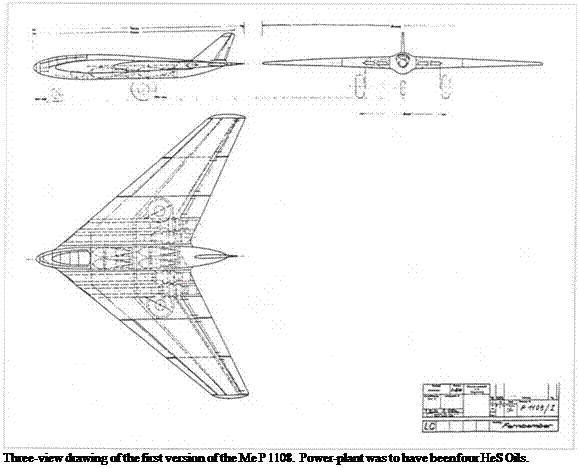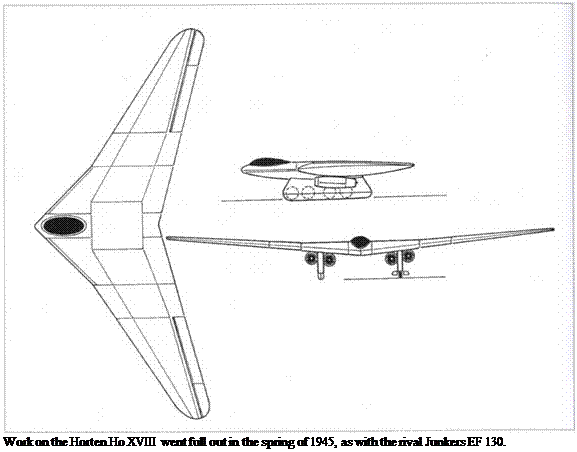Но XVIII and Ju EF130, America Bombers
Along with Alexander Lippisch, the brothers Reimar and Walter Horten were the most influential proponents of the flying-wing principle in Germany. The various Nurfliigel gliders, and also the later twin-jet Но IX, predestined the development team to create far larger aircraft. The work was headed by engineer Naul, aeronautical designers Bollmann and Briinne designed the wings and Piitzer the undercarriage.
In the autumn of 1944 an RLM conference with Horten, Junkers and Messerschmitt called for far more powerful aircraft able to reach targets on the US East Coast and return to Europe without refuelling. AJ1 design offices became involved. At a three-day conference at RLM subsequently it was admitted that neither the Ju 287 with enlarged range had that radius of action, nor did the aircraft planned by Horten and Messerschmitt, although the Horten design had a 60 per cent greater range than all its competitors. Although no contract had been awarded by November 1944, Horten decided to develop the
Но VIII for preliminary tests. Exact details could not be provided to the RLM without the mathematical data and wind-tunnel tests. As provisional engine plant for the future Но VIII it was planned to integrate into the wing six Argus As 10 motors with long-shaft propellers. Using the development details of earlier designs, Horten believed the work could be finished within six months. With a relatively light wing loading of only 53 kg/sq. m (1,250 lb/sq. ft), Но VIII was to be the training aircraft for the heavier, but almost equal sized ultra-long range bomber. Work began in mid-December 1944 and took shape surprisingly quickly during the next three months.

On 12 March 1945 Goring instructed Horten and the commander of Kommando IX to build the first long-range flying-wing bomber, but set no firm completion date. However, this was the order for the Но VIII. When US troops arrived in April 1945, the design work was almost 100 per cent complete, the first

fuselages 50 per cent ready. On 12 March 1945, SS-FHA Amt X is said to have ordered the Но XVIII built. By 23 March the Horten Works had drawn up a project outline for presentation in Berlin, and work on the Но VIII developed from the Но XVIII long-range aircraft continued to the end of March 1945. This three-seater would have had a maximum range of 13,000 kilometres (8,000 miles), inclusive of a 1,000 kilometre reserve. With four SC or SD 1000 bombs, Horten considered that an operational range of 4,000 kilometres was possible, with only one bomb considerable more. Six Jumo 004B turbines were planned to be installed in the wings after calculations showed that the alternative of four BMW 003s would be under-powered. Fuel tanks would hold 16 tonnes. It was also considered giving the Но XVIII two efficient propeller-turbines. A payload of 4 tonnes would have provided an all-up weight of 32 tonnes. For an attack on the United States the bomb-load would have been reduced to one tonne or less to provide an operational reserve of fuel. For short-range work the
bombs would have been carried in a central bay below the fuselage and in two others between the engine blocks and outer wing. On long-range operations part of the bomb bay space would have been given over to disposable fuel tanks. The aircraft could have been refuelled by a Ju 290 in flight as originally planned. Top speed in horizontal flight was thought to be 820 km/hr (510 mph), maximum possible speed of the steel skeleton/wood configuration 900 km/hr (560 mph). Since considerable preliminary work remained to be done as Allied ground forces approached, on 1 April 1945 the Chief-TLR transferred the development to the Harz, but when the time came to place the firm order, the Allies had overrun practically all production centres. In the last few days of the war most of those involved in the Но XVIII projects gave their lives in the defence of the Third Reich. The Но XVIII and the smaller Но VIII remained incomplete. Neither Kammler nor the SS had been able to force through either project as the Reich collapsed.
A second gigantic project, the four-jet Development Aircraft (Entwicklungs – flugzeug) EF 130, the competitor to all designs (including the Но XVIII) submitted to the Chief-TLR, had a powerplant of four HeS Oil jet turbines. The estimated 38-tonne aircraft had a 24-metre (78 ft) wingspan and a large wing surface of 120 square metres (1,300 sq. ft). Because of lack of capacity at Junkers at the beginning of 1945, it was transferred at least partially to DFS. In contrast to the Horten development, the EF 130 would have had a metal fuselage and large wooden wings. The bomb bay had capacity for 4 tonnes and several armoured fuel tanks. The three-seater cockpit was designed as a roomy pressure cabin from where the gunner operated the two remote-controlled defensive barbettes in the fuselage. Initially it was planned to fit four HeS 011 turbines. These were not sufficiently reliable at the beginning of 1945 and four BMW 003 C-l engines were considered instead but were scarce. Top speed would have been 950 km/hr (590 mph) but the maximum flight even with only one 1-tonne bomb was only 7,500 kilometres (4,650 miles), not enough to reach the US coast and return. The EF 130 was abandoned in March 1945 by the Chief-TLR in favour of the Horten design.
Exhortations to step up the pace to build a large jet bomber in March 1945 resulted from the dreams of a leadership blind to the unstoppable approach of defeat. Although no high-value construction materials were available, many lives were sacrificed to force through a senseless project. The excavation of ever more galleries and underground production centres in the spring of 1945 led to an until then unimaginable death rate amongst concentration camp prisoners and forced labourers engaged on the work, but the SS held firm. Not until a day or so before Allied forces reached the bombed-out factories or tunnels in which production had been concentrated did the last SS men give up, throwing down their weapons and leaving to their own devices the slaves who had survived.










